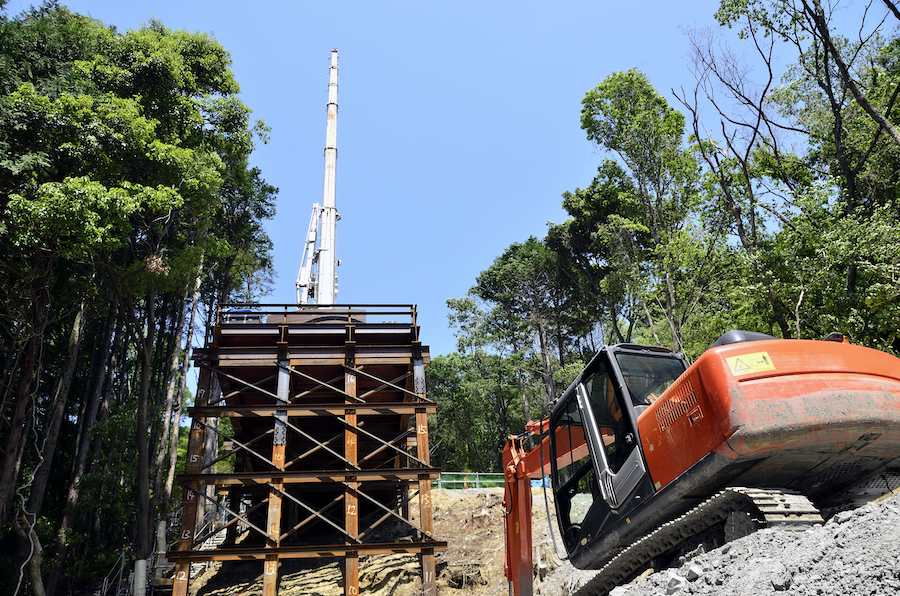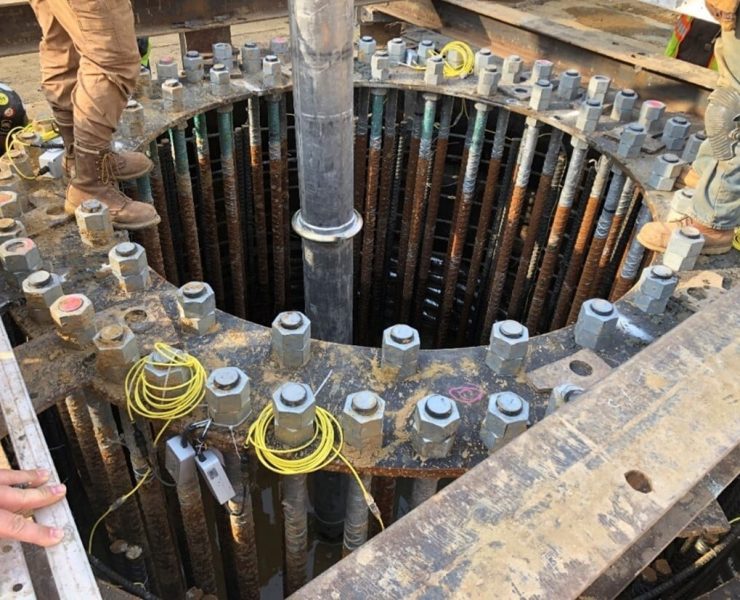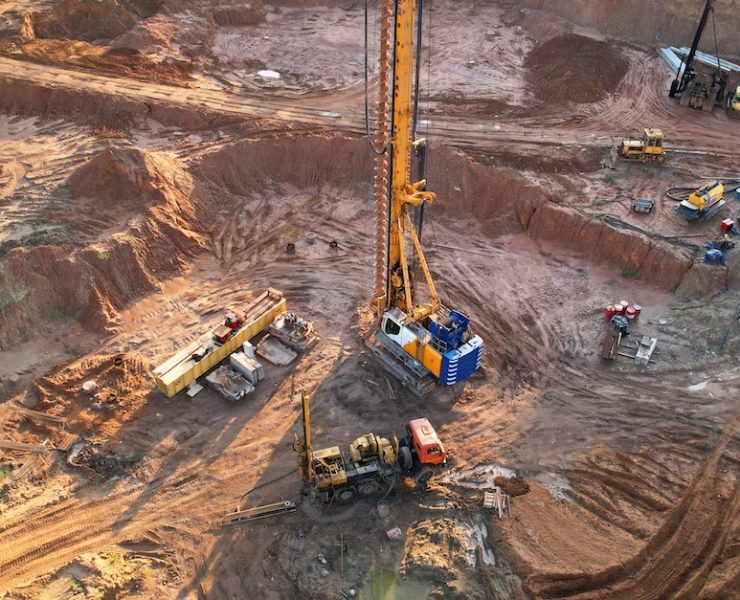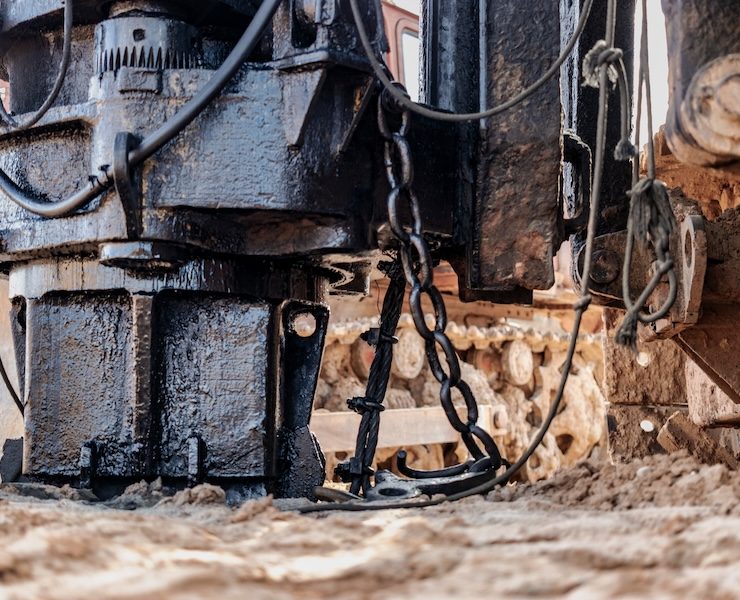Ground Modification Methods For Deep Foundations Part III – Lightweight Fills


View Part II of this article here.
When embarking on a ground modification project, it is important to consider the density of the fill that will be used. Compacted soil fills, such as sands, silts, or clays, can result in significant settlement or decreased stability in certain projects. In these situations, an alternate fill material with a lower unit density can help to reduce the magnitude of applied earth loads.
A lightweight fill material can lead to reduced settlement and/or increased stability. These fills can be used to reduce the applied loads in order to eliminate or significantly reduce the magnitude of embankment settlement or the time to achieve embankment settlement, reduce lateral pressure behind retaining walls and other structures, reduce driving forces in landslide repair, and/or increase an embankment’s resistance to seismic loads.
Historically, a variety of lightweight fill materials have been used for roadway embankment construction, such as tire shreds, wood fiber, boiler slag, fly ash, and geofoam. While there is a range in the unit weights of these fills, all have a lower density than conventional soils. These and other lightweight fill materials have been used for decades. In many cases, these fills are the by-product of a manufacturing process, or made from recycled materials, which can make them more economical choices.
In this article, we will review the most common lightweight fill materials that are used in highway construction. In addition, we’ll provide considerations for design and construction that are unique to each type of lightweight fill material.
Feasibility Considerations
Lightweight fill materials can be used in a variety of ways in highway construction, including where the capacity of the underlying soil is too low to carry the design load, and/or when the estimated settlement of an embankment is too large. When this occurs, the foundation soils must either be improved or bypassed, and the embankment load must be reduced. Lightweight fills can work to reduce the embankment load.
When a fill is placed on soft ground, the driving force is from the weight of the embankment itself. To improve foundation stability, the soft soil could be reduced and replaced with compacted select fill, deep foundations could be used to transfer the load, surcharging may be used to speed consolidation and the development of shear strength, stabilizing arms could be installed, or ground modification techniques could be employed. Each of these techniques can be costly and time-consuming, and may require specialized equipment in experienced labor.
In these situations, the use of a lightweight fill material may be preferable to increase the overall stability of the fill by reducing the driving forces. In addition, lightweight fill material can reduce settlement under loading in proportion to the reduction in load.
Shear Strength
Granular lightweight fills have an angle of shearing resistance that is similar to natural soils. Cellular lightweight fills have greater compressive strength. This leads to internal stability within the lightweight fills. The shear strength developed as a result of the lightweight fill deposits will increase the overall stability of an embankment over a weak foundation.
Compressibility
Most lightweight fill materials have a compressibility and elasticity that is similar to natural soils or rock. With static loading, the amount of internal compression will often be similar as it would be for conventional earth fill materials. With dynamic loading, the resiliency of the lightweight materials will be similar to natural soils.
The compressibility of some lightweight materials, such as shredded tires or wood fibers, is significantly larger than compacted soils. This must be taken into consideration in the design process. In addition, these materials have a much larger resiliency than conventional soils, requiring a cover of at least 3 feet of soil to reduce resiliency, allowing pavements to be built on these deposits.
Lateral Pressures
For many lightweight fills, the cohesion of the material is high while the density is comparatively low. This can result in a significant reduction in the amount of lateral earth pressure that is transmitted to adjacent structures, such as pile foundations, tunnels, or retaining walls.
Drainage Characteristics
Many granular lightweight fill materials have superior drainage characteristics, which is favorable in pavement design. The presence of free water in the subgrade can result in pumping at joints in reinforced concrete pavements, plastic deformation of the subgrade soils, which can lead to rutting, high pore water pressure under traffic loading, and heaving of the pavement where frost penetrates the subgrade. When used behind a retaining wall, lightweight fill with good drainage can also eliminate hydrostatic pressures.
Construction in Adverse Weather
It can be difficult or even impossible to place and compact conventional soils when the weather is extremely cold or wet. Certain lightweight fills, such as EPS-block geofoam, can be successfully installed in poor weather conditions.
Advantages and Potential Disadvantages
Any lightweight fill material has both advantages and disadvantages. Understanding these is vital to making an informed choice about whether to use a lightweight fill — and if so, which lightweight fill to use.
Lightweight fills can be used in a number of applications to perform a variety of functions. The advantages of using a lightweight fill include accelerating construction, reduce structural resistance requirements for lateral and vertical loads, reduce magnitude of and time for consolidation of soft soils and settlement of embankment and structures, and to eliminate or reduce stability issues.
However, there are disadvantages and limitations to using lightweight fill materials. Many of these issues can be overcome with proper evaluation, design, and construction. These limits include potential unavailability of particular materials, the need for special construction methods, durability of fill deposits, environmental concerns, and distinct geothermal properties.
Lightweight Fill Materials
Lightweight fill materials may be either manufacturers or recycles. Manufactured materials are specifically developed for special design situations, and typically cost more than recycled materials. In contrast, recycled materials are left over from an industrial or commercial process, which may have been considered waste products in the past. There are two broad categories of lightweight fill materials: those with compressive strength that behave similarly to cohesive soils in undrained loading, and those that have properties that are similar to granular soils.
Lightweight Fill Materials with Compressive Strength
Geofoam is a generic name for any cellular material that is used in geotechnical applications. The most common geofoams that are used as lightweight fill included block molded expanded polystyrene (EPS) and extruded polystyrene (XPS), both of which are manufactured.
EPS is made by expanding small beads of polystyrene into spheres with numerous closed cells. These spheres are then fused into blocks in a heated vacuum chamber. This heat welds the beads together to form a very light material with a high void content. EPS has an extremely low density with relatively high strength and stiffness. EPS blocks are similar in shape to large bricks, with a typical dimensions of 4 to 16 feet long, 12 to 48 inches wide, and 24 to 48 inches thick. Blocks can be made to different sizes, and factory or field cut to a number of sizes and shapes.
Another type of lightweight fill material with compressive strength is lightweight cellar concrete. This material is produced by introducing preformed foam into a cement water slurry. This creates a network of discrete air cells within the cement. This mixture may be made at the job site or thoroughly mixed at a plant and then transferred to the site in a ready-mix truck. In most cases, companies that supply these proprietary foaming agents will blend the materials on site and pump it to the required location.
These materials can be blended to a specified density and then pumped into place. It is generally cast in lifts that range from 1 to 4 feet, depending on the application. Hydration solidifies the mixture so that vibratory compaction is not required. After 12 hours of curing, subsequent lifts can be placed.
Granular Lightweight Fills
Tire shreds are produced by cutting tires via machine into chips that range from 4 to 8 inches in size. These chips have a low compacted density, are durable, coarsely grained, and free draining. A large number of tires — both settle and glass belted — can be used in highway construction, as each cubic yard of tire shred fill contains about 75 passenger vehicle size waste tires.
Tire shred embankment fills are typically limited to a maximum thickness of 10 feet, are encased in a geotextile, covered with soil, and used above the groundwater table. Tire shreds may also be mixed with soil to create a composite fill for embankments, or bound together to create tire bales.
Because tire shreds are a waste product, the primary costs associated with this material is shredding and transportation. Some states provide rebate incentives for using scrap tires.
Wood fiber can also be used as a granular lightweight fill. This material includes any type of wood waste that is generated at a sawmill, including sawdust, planer chips, and hog fuel (primarily bark and pulverized wood that has been stripped from logs). The availability of wood fill depends on proximity to locations with a significant timber industry.
Synthetic aggregates may also be used as granular lightweight fills. This includes expanded shale, clay and slate (ESCS). This material is created by heating these materials to temperatures ranging rom 1,000 to 1,2000 degrees Celsius. IN this process, the clay minerals become completely dehydrated, and will not re-hydrate. This mass is then screened to produce the desired gradation. The aggregate typically has a hard ceramic outer core with a system of pores that vary in size. This material is durable, chemically inert, and generally insensitive to moisture.
The cost to produce ESCS is relatively high because it is manufactured. As a result, this material is usually used as lightweight aggregates for structural concrete. It may be used for embankment fill, but a naturally occurring, high-quality material is usually preferred if available.
Fly ash — the residue collected in a smoke stack when coal is burned — is another type of lightweight granular fill. Fly ash consists of very fine particles that are largely the size of silt. These particles are rounded and are composed of a siliceous material. The exact chemical properties of fly ash are dependent on the type of coal that is burned. Fly ash may be used as an ingredient in concrete, including in manufacturing lightweight cellular concrete. The demand for this byproduct has raised the cost of fly ash.
Blast furnace slag can also be used as a lightweight granular fill. It is generated from the production of iron. The slag is the slice and alumina from the original iron ore that has been combined with oxides from the flux stone. It leaves a blast furnace in liquid form, and may be produced in one of three ways, depending on how it is cooled.
Air-cooled slag is allowed to run into a pit, where is solidifies and cools. The slag is then dug, crushed and screened, resulting in uniformly graded slag with the lowest density. In contrast, expanded slag involves treating the molten slag with water to produce a lightweight product. Finally, granulated slag is formed from molten slag that is quickly chilled. The resulting slag is glassy, and may be crushed, screened, or pulverized. Air-cooled slag is the most commonly produced form of slag that is processed in the United States. It is typically used as an aggregate for lightweight concrete or concrete block.
Boiler slag may also be used as a lightweight granular fill. It is a coal combustion byproduct from power plants, made from molten ash that is collected in wet, water cooled bottom boilers. This material is a durable aggregate that consists of angular glassy black particles of irregular shape.
Design Concepts
The purpose of using lightweight fills is to reduce the load on the foundation. To determine which lightweight fill is best, contractors and/or engineers must evaluate a number of factors, including the availability of lightweight fill materials, the geotechnical engineering properties of the material, drainage requirements and characteristics, the durability, compressibility, water absorption and degradation potential, costs, and design and construction considerations. These issues are addressed below by fill material type.
EPS-Block Geofoam
EPS-block geofoam does not have known environmental concerns. From a design standpoint, EPS blocks will absorb water when placed in the ground. Buoyancy forces should be considered for blocks that are situated below the water table, with adequate cover to protect against uplift. As petroleum products will dissolve geofoam, a geomembrane or reinforced concrete slab should be used to cover the blocks in the event of accidental spills. The risk of icing is higher with EPS blocks, which can be minimized by providing sufficient soil between the EPS and the top of the pavement surface.
For construction, the subsoil should be leveled before the blocks are placed, typically with sand/or gravel placed. If multiple levels of geofoam blocks are placed, the blocks should be placed at right angles to avoid continuous vertical joints and to promote interlocking. A cover material should be placed over the blocks to prevent displacement from wind or buoyancy. A mechanical connection between the blocks should be provided with a galvanized barked plate.
Cellular Lightweight Concrete
There are no known environmental concerns with cellular lightweight concrete. For design purposes, the dry density values are lower than wet density values, and buoyancy may be an issue if the foamed concrete is placed below the water table. Lower compressive strength mixes may be affected by free-thaw cycles, so mixes with higher compressive strength should be used in areas where the zone is below freezing. Water may be absorbed into the voids, which may affect density and compressive strength.
When it comes to construction, a standing area is necessary for batching, mixing, and placing on site. Foamed concrete is very fluid. As suck, formwork should be tight to prevent the flow of mix through joints or gaps. If the foamed concrete is placed in a confined area, then forms are not necessary. The lift thickness should not exceed 4 feet, with a minimum of 12 hours between placements.
Granular Lightweight Fills
For tire shreds, care must be taken to minimize leaching of chemicals from the material. Similarly, there is some combustion potential, so the design must take both of these factors into account. The layers should be limited to 10 feet in thickness, with the fill placed above the water table. Surface drainage should be provided to avoid water seepage through the fill. The material should be separated from the soil by wrapping it completely with a geotextile, with metal fragments firmly attached to the chips. A minimum soil cap of 3 feet should be placed on the top and side slopes. The top of a tire shred embankment should be at least 5 feet below the top of subgrade elevation, with multiple 10 foot layers separated by 3 feet of soil fill.
For construction, tire shreds can be spread using a track mounted dozer, and then compacted using rollers or repeated passes with a dozer. Volume reduction is approximately 35% during compaction.
For wood fiber, there are potential environment concerns, including contamination of water with toxins, lowering of the pH of the groundwater, depletion of available dissolved oxygen in groundwater. This can be addressed in design by reducing water infiltration into wood fiber through drains and capping and barriers between the fill and adjacent bodies of water. In terms of design, the particle size should be no greater than 6 inches to prevent large voids from forming. Fresh wood fiber should be used to prolong the life of the fill. A cover material with a thickness of 2 feet or more should be used to protect slope from erosion and minimize deterioration of the wood fibers. The height of the fill should be limited to 16 feet.
In construction, truck-mounted equipment can be used to spread the fiber. Two passes with a fully loaded hauling truck is usually enough to properly compact the wood fiber.
For ESCS, there are no known environmental concerns. In the design process, attention should be paid to the absorption of water, as it will absorb water after placement. The side slopes should be covered with at least 2.5 feet of soil cover. In construction, rubber tired rollers should be used to avoid particle degradation. The fill should be unloaded at the side of the fill area, and then distributed using lightweight equipment.
With fly ash, the material may leach and migrate. However, the EPA has classified fly ash as non-hazardous. When designing this fill, certain factors should be taken into consideration, such as using a drainage blanket when the groundwater table is high to promote a capillary cutoff and prevent frost heave. If concrete will be formed on the fly ash, a barrier should be placed to prevent moisture absorption from the concrete. During construction, it is important to remember that fly ash behaves like silt, so water may be necessary to prevent dusting. Compaction can be obtained using smooth drum vibratory rollers or self-propelled, pneumatic-tired rollers.
For air-cooled blast furnace slag, there are concerns with the pH content and sulfur content. The aggregate may be washed to control the Ph level or to meet specifications. There are not any known environmental concerns with this particular fill. When designing the project, uniformly graded materials should be specified for lightweight fill. Because slag is highly resistant to weathering and abrasion, it can be placed below the water table and next to bodies of water. It can be placed in the same way as natural gravel and sand.
Boiler slag does not have any known environmental concerns. In terms of design, side slopes should be covered with at least 2 feet of cover material to increase stability. It can be used as an under drain filter material, if the gradation requirements are met. During construction, it should be compacted with several passes of a roller, with water content at our above optimum water content to prevent loss of stability.
Construction Specifications and Quality Assurance
When developing specifications for lightweight fill materials, consideration should be given to the type of fill being used. For lightweight fill materials with compressive stress, the specifications should include the minimum compressive and/or flexural strength, the type of lightweight fill material to be used, and the life thickness or block dimensions.
For granular lightweight fills, the specifications should include the type of material to be used, the gradation of the fill material, tests on absorption, durability, or other factors, the lift thickness, placement and compaction procedure, and the method of payment (based on the amount of fill to be supplied in cubic meters).
Quality assurance is an important aspect of this process as well. For cohesive lightweight fill materials, measurements of the density and the compressive strength should be performed in the field. Samples should be taken for quality assurance testing, and the placement of EPS geofoam blocks should be monitored to confirm that they are placed appropriately. For foamed concrete, samples of the freshly mixed fill should be taken at the site, and the lift thickness of each pour should be measured.
For granular lightweight fill materials, both monitoring and construction control will generally follow the same process as used for conventional soil placement and compaction. Lift thickness, number of passes, degree of compaction and moisture content should all be monitored. In addition, a check on the graduation of the materials should be performed.
For tire shreds or wood fibers, field monitoring should include measurement of lift thickness and number of passes with compaction equipment. Virtual observations should also be made to determine the resiliency of the deposit to determine if additional passes are necessary. If tire shreds are to be used, field mounting should confirm that material specifications are met, with no excessive steel wire within the shreds. With wood fiber, the material should be checked daily to ensure that there is a blend of sizes and only fresh wood is being used.
Cost Data
The cost of lightweight fill materials may vary significantly based on the underlying cost of the material (byproduct versus manufactured product), transportation costs, quantity of material, availability of materials and placement and/or compaction costs.These costs should be calculated using a common denominator. While many materials are supplied by the ton, the density of the materials varies greatly. Instead, a cost per in-place cubic yard should be used.
Generally, manufactured products — such as cellular concrete and EPS-block geofoam — are the most expensive types of fill, while recycled and byproduct materials are comparatively inexpensive. For example, EPS-block geofoam may range in price from $40 to $60 per cubic yard at the source, while boiler slag may be priced at $2 to $3 per cubic yard. Additional cost considerations such as transportation and compaction methods should be factored into any evaluation.
Lightweight fill materials are particularly useful for construction projects where necessary to reduce the settlement of a load. In many cases, the use of lightweight fill is more economical and better for the long-term stability of a project. However, because each type of fill has specific advantages and disadvantages, the potential use of a lightweight fill material should be carefully analyzed during the design process before making any final decisions.
View Part II of this article here.
Why should I consider using lightweight fill materials in my construction project?
Lightweight fill materials can reduce settlement, increase stability, and offer advantages such as accelerating construction, minimizing structural resistance requirements, and addressing various geotechnical challenges.
What are the main factors to consider when choosing between different lightweight fill materials?
Considerations include the geotechnical properties, environmental impact, cost, and construction requirements specific to each type of lightweight fill material, ensuring compatibility with project needs and local conditions.

















